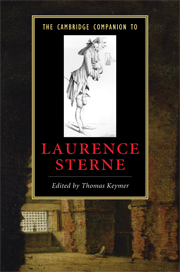Book contents
- Frontmatter
- Introduction
- 1 Laurence Sterne’s life, milieu, and literary career
- 2 Scriblerian satire, A Political Romance, the ‘Rabelaisian Fragment’, and the origins of Tristram Shandy
- 3 Tristram Shandy, learned wit, and Enlightenment knowledge
- 4 Tristram Shandy and eighteenth-century narrative
- 5 The Sermons of Mr. Yorick: the commonplace and the rhetoric of the heart
- 6 A Sentimental Journey and the failure of feeling
- 7 Sterne’s ‘politicks’, Ireland, and evil speaking
- 8 Words, sex, and gender in Sterne’s novels
- 9 Sterne and print culture
- 10 Sterne and visual culture
- 11 Sterne and the Modernist Moment
- 12 Postcolonial Sterne
- Further reading
- Index
- Series List
11 - Sterne and the Modernist Moment
Published online by Cambridge University Press: 28 January 2010
- Frontmatter
- Introduction
- 1 Laurence Sterne’s life, milieu, and literary career
- 2 Scriblerian satire, A Political Romance, the ‘Rabelaisian Fragment’, and the origins of Tristram Shandy
- 3 Tristram Shandy, learned wit, and Enlightenment knowledge
- 4 Tristram Shandy and eighteenth-century narrative
- 5 The Sermons of Mr. Yorick: the commonplace and the rhetoric of the heart
- 6 A Sentimental Journey and the failure of feeling
- 7 Sterne’s ‘politicks’, Ireland, and evil speaking
- 8 Words, sex, and gender in Sterne’s novels
- 9 Sterne and print culture
- 10 Sterne and visual culture
- 11 Sterne and the Modernist Moment
- 12 Postcolonial Sterne
- Further reading
- Index
- Series List
Summary
'To define--is to distrust', as Tristram triumphantly informs Eugenius, although he immediately realises he has a victory without laurels: 'I triumph'd over him as I always do, like a fool' (TS 3.31.258). Similarly, I have foolishly managed over the past fifteen years to write about Sterne and modernist authors without ever defining modernism or postmodernism. I have, for example, written about Sterne and Proust, Sterne and Nietzsche, Sterne and Svevo, but have continued to believe all along that Sterne is neither proto-modernist nor proto-postmodern, neither an anticipation of Joycean stream of consciousness nor a foretaste of a Derridean breakdown between signified and signifier (which, assuredly, first happened in Eden, not in Paris). Rather, Sterne, like all great artists, was a writer of his own time and place; all that we can really mean when we assign a prophetic aura to his work is that authors of a later period have read Sterne in ways that we must now take seriously, their powerful lenses proving to be filters we are unable to avoid. As I expressed it in explaining Proust's influence on Sterne: 'twentieth-century readers, reading the best that has been produced in their own century, come to earlier literature through that experience and cannot free their reading from it'. With this in mind, let me define modernism in the narrowest possible sense, keeping in mind that by modernism I mean modernism, and 'nothing more, or less', as Sterne says about defining the word nose (TS 3.31.258). It was a condition of Western thought that started with Nietzsche, but perhaps earlier with Kierkegaard, and perhaps before that with Hume and Kant - a condition that some believe ended with the anointing of postmodernism and Derrida at Johns Hopkins University in 1968, although here, again, precursors might be discovered, every messiah having had his John the Baptist.
- Type
- Chapter
- Information
- The Cambridge Companion to Laurence Sterne , pp. 160 - 173Publisher: Cambridge University PressPrint publication year: 2009

